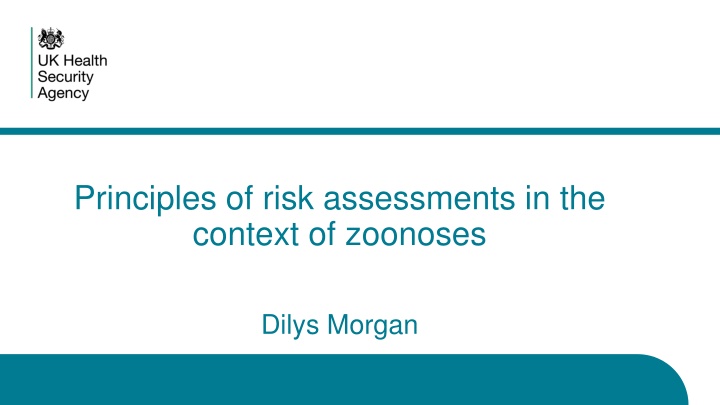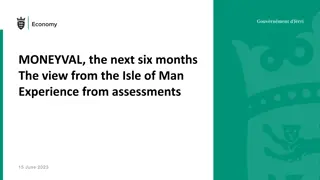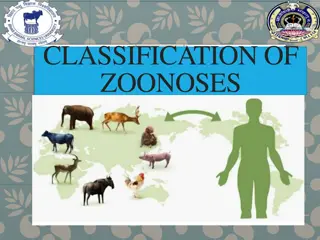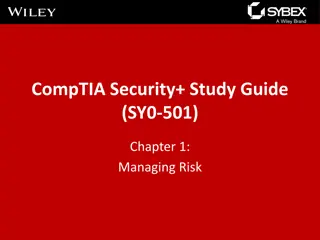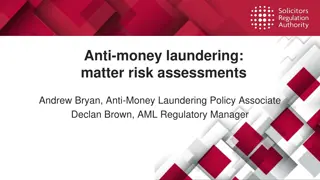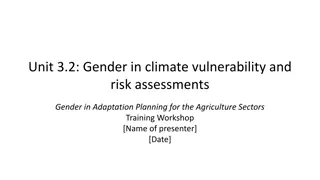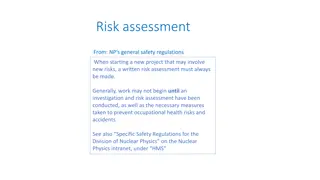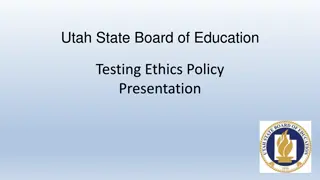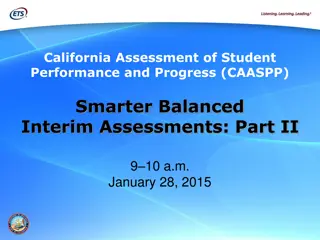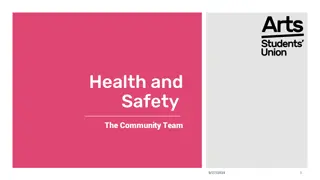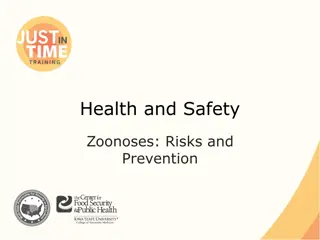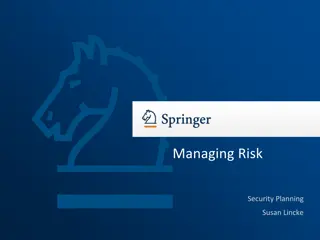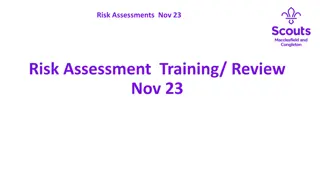Principles of Risk Assessments in Zoonoses Context
Risk assessment in zoonoses involves hazard identification, risk analysis, management, and communication. Understanding hazards, threats, and risks are essential. Learn why risk assessment is crucial for informing stakeholders, preparedness, guidance, media, policy advice, and reassurances. Explore the zoonotic potential of emerging infections. Discover a range of risk assessment methodologies for handling zoonotic diseases effectively and taking a multisectoral, one-health approach.
Download Presentation

Please find below an Image/Link to download the presentation.
The content on the website is provided AS IS for your information and personal use only. It may not be sold, licensed, or shared on other websites without obtaining consent from the author.If you encounter any issues during the download, it is possible that the publisher has removed the file from their server.
You are allowed to download the files provided on this website for personal or commercial use, subject to the condition that they are used lawfully. All files are the property of their respective owners.
The content on the website is provided AS IS for your information and personal use only. It may not be sold, licensed, or shared on other websites without obtaining consent from the author.
E N D
Presentation Transcript
Principles of risk assessments in the context of zoonoses Dilys Morgan
Risk assessment Is a component of risk analysis Hazard identification Risk assessment Risk management Risk communication
Hazard Anything with the potential to cause harm The presence of a hazard does not automatically imply a threat. Threat A potentially damaging event or incident Risk Combination of the consequences (impact) of an event or incident (hazard/threat) and the associated likelihood (probability) of a harmful effect to individuals or populations & impact
Why risk assessment? Inform risk managers Alert and inform those who need to know about events in a comparative and consistent way Preparedness and forward planning Provide appropriate guidance and advice wide range stakeholders Inform media Advise policy and policy makers* Provide reassurances that robust system are in place
Since most emerging infections are zoonotic in origin, taking a one health approach to infections/ incidents emerging at the human-animal interface is crucial Includes assessing the zoonotic potential of new animal conditions
Range of RA methodologies https://assets.publishing.service.gov.uk/ government/uploads/system/uploads/att achment_data/file/761106/HAIRS_risk_a ssessment_processes.pdf http://apps.who.int/iris/bitstream/10665/ 70810/1/WHO_HSE_GAR_ARO_2012.1 _eng.pdf https://ecdc.europa.eu/sites/portal/files/ media/en/publications/Publications/1108 _TED_Risk_Assessment_Methodology_ Guidance.pdf
An Operational Tool of the Tripartite Zoonoses Guide Taking a Multisectoral, One Health Approach: A Tripartite Guide to Addressing Zoonotic Diseases in Countries http://www.fao.org/publications/card/en/c/CB1520EN/
Qualitative vs quantitative RAs A quantitative assessment requires calculations of two components of risk: the probability and the impact and it will produce a numerical risk score often of unknown accuracy. Useful for known risks where data defining the probability and impact are available Beware headline figures based on dodgy data A qualitative assessment more useful approach for a rapid risk assessment, as it is possible with limited information Easier to outline uncertainties Use consistent terms to describe risk parameters
Risk parameters Risk = Probability x impact context The risk to a population from a communicable disease is dependent: on the probability or likelihood of transmission in the specified population and the impact should infection occur Risk may be influenced by context or the broad environment in which the threat occurs, including political, public, media interest and perception of risk. More useful to report probability and impact, but policy makers usually want an overall risk
Rapid risk assessment Once an incident verified as being of potential public/animal health concern, a rapid risk assessment is undertaken to evaluate the risk to human/animal health Initial assessments can be complex and challenging: produced within a short time period when information is often limited circumstances can evolve rapidly need to be revised frequently Should still be based on all available information/evidence clear estimate of the scale of the health threat Be clear on exactly what threat, to whom, and where
Rapid risk assessment The outcome of the rapid risk assessment will determine: the degree of escalation of communications whether a response is indicated the urgency and magnitude of response the design and selection of critical control measures will inform the wider implications and further management of the incident The assessment should provide information to support risk management, prioritise resources and aid communication
Rapid risk assessment process Qualitative. Rapidly communicate risk in a hierarchy of robust and consistent terms e.g. Impact and Likelihood [risk] Very low High Low Very high Moderate Agreed by group
RRA and evidence underpinning RA The quality of the evidence underpinning the risk assessment should be assessed based on the source, design and quality of each study or piece of information. Uncertainties should be identified, clearly documented and communicated and the assessment updated in light of new evidence over time. Expert knowledge - important to distinguish between knowledge based on good research, and experience and opinion-based knowledge
Quality of Evidence Good (i.e. further research unlikely to change confidence in information) Satisfactory (i.e. further research likely to have impact on confidence of information and may change assessment) Unsatisfactory (i.e. further research very likely to have impact on confidence of information and likely to change assessment) Confidence [uncertainty] in the RA
Assigning an estimate of confidence [uncertainty] Confidence/uncertainty included in output of RRA
Summary 1 Risk assessments often have to be undertaken very rapidly and based on very poor evidence Often under intense professional, political and media attention Good scientific evidence should underpin RA process and any resulting guidance Gaps in knowledge and assumptions need to be clearly outlined in the risk assessment Confidence /uncertainty gives an overview of quality of evidence Ensure complete documentation of process with clear version control - act as log for decisions and actions and then all decisions become easier to explain and justify
Summary 2 Risk assessments should : Be transparent, systematic and objective Rapid and reproducible Identify the need to move to an expert formal risk assessment Used to promote risk-informed decision making Communicated Best done in a multidisciplinary, cross-sectoral team who sign up to the risk assessment and risk statements
Summary Sound objective risk assessments do not always result in appropriate policy, interventions, actions, guidance and media reports Difficult for low probability/ high impact events Often about managing expectations rather than actual risk Beware the Risk of Risk Assessments!! Risk assessments underpin most animal, public health and environmental issues, but ensuring are evidence-based and robust minimises risk
